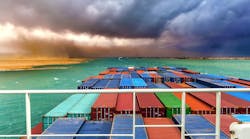Expect Backlogs, Not Valentines, from China in February
Ask anyone who depends on products that come out of China how confident they are that the supply chain is reliable, and you will hear stories of product price increases, higher logistics costs and shortages.
Before the Omicron COVID variant hit, there was a growing confidence that the worst was behind us, but now that is tempered. Many in the West are relieved that Omicron has proven to be less deadly than Delta; however, executives that I speak with are expressing a lot of concern around what February will hold for goods exported from China.
Things are likely to get more challenging based on Beijing’s response to Omicron—particularly when coupled with ongoing logistics constraints, Lunar New Year’s and the Beijing Winter Olympics. Any one of these events could disrupt supply chains with origins in China, but together they have the potential to be the perfect storm.
Looking back at 2021 and the Delta lockdowns in China gives us a good model for Beijing’s response to Omicron. My team at supply-chain consultancy Seraph and I expect that China will continue to follow the “zero tolerance” strategy, but with a virus where the R0 (basic reproductive number, i.e., an indicator of how contagious the virus is) is higher than Delta, it is unclear how many areas will need to be locked down.
Leveraging manufacturing bubbles might have worked in the past, but there will be increased desire for people to gather for the Lunar New Year—and a repeat of workers being unable to return to their manufacturing jobs after the holiday would be devastating for many industries.
Lockdowns Are Already Happening
As of this writing, China has yet to indicate that it will stop travel for the Lunar New Year. An infrastructure was put in place to support Covid lockdowns, and there is little indication that the government is willing to abandon “zero tolerance.” We are already seeing lockdowns in Tianjin, where VW, Micron and Airbus have suppliers and production. Shenzhen has select control measures in place but is not yet in full lockdown. In recent weeks, sporadic outbreaks scattered across the country of both the Delta and Omicron variants have already triggered shutdowns to automotive, clothing factories and energy deliveries around one of China’s biggest seaports in Ningbo, as well as disruptions at computer chip manufacturers in the locked-down city of Xi’an and a second citywide lockdown in a different province.
Expect More Backups
Ports in China have also been impacted by Omicron, and while operations have not halted, bottlenecks are growing. Ships continue to pile up off the coast of Long Beach, Calif.; the ship time of containers from China to the U.S. remain many times higher than pre-pandemic; and goods are sitting in Chinese ports for extended periods.
When the Chinese bottlenecks finally burst, it will create a renewed wave of pressure as they arrive at U.S. ports. These higher costs and increased delays are the current state in mid-January; if we hit a long shutdown, expect both the cost of shipping and time from manufacturing to end customer to continue to grow. In an overloaded system, any additional pressure will likely have a significant impact and will create backlogs that will drive prices higher for a minimum of six and possibly as many as 18 months.
Shipping containers by sea is the single largest challenge that the Chinese export engine must address, and keeping ports open and functioning at full capacity is essential. The port of Ningbo, the third-largest port in the world, has registered at least 20 COVID cases as of writing this and a lockdown is likely. Restrictions in Shenzen are raising concerns of delays at nearby Yantian port, which is one of the biggest container ports in Asia and was partly closed for a month last year after an outbreak. We predict a significant impact as port capacity is reduced or shutdowns begin.
Lunar New Year Looms
The Lunar New Year is one of the most important celebrations of the year in most Chinese communities. People make extra effort to travel back to their families and to spend time with the people who are important to them—especially important to many after last year’s lockdown. The celebration occurs on January 31 and February 1; however, most businesses close for at least a week. In the West, most industries plan for the Lunar New Year and order accordingly; however, this year the power outages at manufacturing plants, Covid-related production delays and logistics challenges have increased the risk of an impact over the Lunar New Year period.
Olympic Wild Card
The real wild card in the equation is the Beijing Winter Olympics from February 4 to 20. Seraph has been advising clients to expect supplier plants at certain Chinese cities to be forced to close to improve air quality in the regions around the Olympic venues. The general rules around the Olympics may result in proactive lockdowns during or immediately after the games.
The Seraph risk model shows high probability that a lockdown after the games will occur. If this lockdown impacts major manufacturing areas or ports, the impact will be significant across the global economic environment.
While it is late to take major mitigation efforts, companies should have early warning indicators and be constantly monitoring their supply chains. Seraph will continue to monitor events around Covid, the Lunar New year and Olympics for indications of disruptions and we encourage our clients to do the same. We all hoped that 2022 would calm our supply chains, but what we are seeing is that the 2020s will likely be the decade where skilled professionals remain in demand to monitor and manage the complexities around even the most effective supply chains.
The move towards regionalization is accelerating, but this will take time. Until we see the long-term fix of more regional manufacturing we expect to see ongoing supply chain disruptions coming out of China.
Ambrose Conroy is Founder and CEO of Seraph, an expert global supply chain/manufacturing turnaround consultancy. He launched the firm to bring together a collection of top industry talent to help firms take action to improve their operations. Prior to Seraph, Ambrose was the Vice President of Supply Chain Solutions at NAI Global. His areas of expertise include M&A, Crisis Management, Restructuring & Turnaround.





